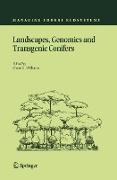Landscapes, Genomics and Transgenic Conifers
BücherAngebote / Angebote:
What is the future of genetically modified (or transgenic) conifer plantations? The content of this edited volume Landscapes, Genomics and Transgenic Conifers addresses this question directly - and indirectly - using language drawn from policy, forest history, genomics, metabolism, pollen dispersal and gene flow, landscape ecology, evolution, economics, technology transfer and regulatory oversight. Although the book takes its title from a Nicholas School Leadership forum held November 17-19, 2004 at Duke University, its de novo contents move past the forum’s deliberations. The result is a trans-disciplinary book composed of 14 chapters written by a total of 31 authors working in North America, South America, Europe and Africa.
The book is written for policy experts, life scientists, government and business leaders, biotechnology writers and activists. Few decision-makers realize the unprecedented degree to which transgenic technology is now possible for forests on a commercial scale. Only a handful of the 550 living conifer species used for commodity value and even fewer species are being developed for transgenic plantations. Transgenic field trials started within the last decade but no transgenic pine plantations exist in 2005. But emergence of transgenic forest trees is still so recent that dialogue about the pros and cons is confined to the scientific community. And dialogue must move out into the public domain.
The goal of this volume is to provide content for public deliberations about the genetic composition of future forests. Its Section I is composed of provocative and opposing views on the question of transgenic conifer plantations. Sections II and III follow with research advances on relevant conifer genomics and ecology research, respectively. Section IV forecasts rates of technology adoption for different case studies. Finally, Section V compares the status of regulatory oversight of transgenic forest trees between Canada and the United States. But will the book fulfil its goal? The burden of the answer lies with its readers. Will readers act – or will transgenic forests be seen as too remote or simply too rural to bother with the angst of public deliberation?
Folgt in ca. 10 Arbeitstagen

